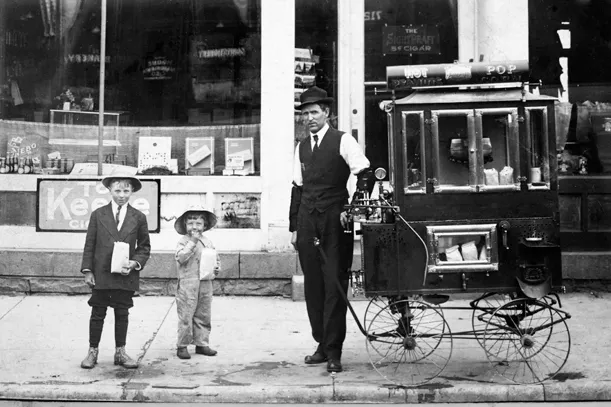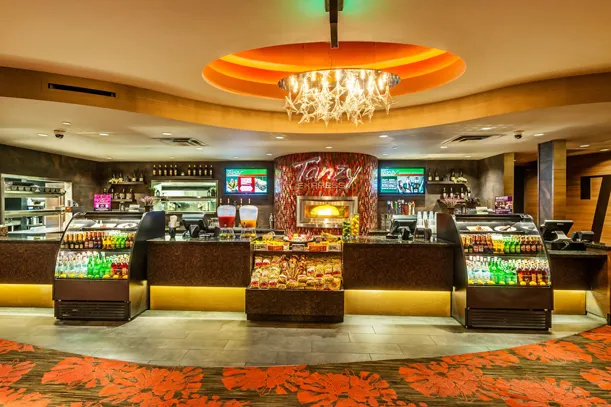Did You Know You Can Get a Popcorn and Drink for Only 65 Cents
/https://tf-cmsv2-smithsonianmag-media.s3.amazonaws.com/filer/bc/32/bc328d3e-22e2-41e4-b3d5-a230015d7f00/42-36911842.jpg)
Moving-picture show theater popcorn is a concession stand up staple whose scent has spawned marketing ploys and copycat recipes, only motion-picture show theaters haven't always been saturated with the tempting smell of salt and butter. The history of popcorn is vast, and it intersects with movies in the relatively recent by–a symbiosis of taste and place created to relieve the fledgling movie house industry from near collapse during the Great Low.
Most eight,000 years ago, maize was cultivated from teosinte, a wild grass that doesn't look much like the mod corn nosotros know today. Popcorn–a name by and large associated with puffed kernels of corn–is actually a strain of corn, characterized by specially starchy kernels with hard kernel walls, which help internal force per unit area build when placed over heat. It was one of the starting time variations of maize cultivated in Central America. "Popcorn went due north and it went south, but every bit far as I can see, information technology actually only survived in South America," says Andrew Smith, author ofPopped Culture: A Social History of Popcorn. Eventually, trade and commerce brought the unique kernels northward. "Most probable, Northward American whalers went to Chile, found varieties of popcorn, picked them up and thought that they were beautiful, and brought them back to New England in the early on 19th century," Smith explains.
Afterwards popcorn made its style to the eastern part of North America, information technology spread rapidly. Eaters found the act of popping corn wildly entertaining, and by 1848, popcorn, the snack nutrient, was prevalent enough to be included in theDictionary of Americanisms. Popcorn had literally exploded onto the scene and was available everywhere—especially at entertainment sites like circuses and fairs. In fact, there was really just one entertainment site where the snack was absent: the theaters.
One reason for popcorn'south increasing popularity was its mobility: in 1885, the first steam-powered popcorn maker hitting the streets, invented by Charles Cretor. The mobile nature of the machine made it the perfect production auto for serving patrons attention outdoor sporting events, or circuses and fairs. Not only was popcorn mobile, but it could be mass-produced without a kitchen, an advantage that another crunchy snack—the murphy bit—lacked (the earliest potato chips were made in pocket-size batches in kitchens, non ideal for mass snack appeal). Another reason for its potency over other snacks was its appealing olfactory property when popped, something that street vendors used to their advantage when selling popcorn. Still, movie theaters wouldn't permit the pop street snack into their auditoriums.
"Flick theaters wanted nothing to do with popcorn," Smith says, "considering they were trying to duplicate what was done in real theaters. They had cute carpets and rugs and didn't want popcorn being ground into it." Motion picture theaters were trying to appeal to a highbrow clientele, and didn't desire to deal with the distracting trash of concessions—or the distracting noise that snacking during a film would create.
When films added audio in 1927, the movie theater industry opened itself up to a much wider clientele, since literacy was no longer required to attend films (the titles used early silent films restricted their audience). By 1930, attendance to movie theaters had reached 90 million per week. Such a huge patronage created larger possibilities for profits—especially since the sound pictures now deadened snacks—but motion picture theater owners were still hesitant to bring snacks within of their theaters.
The Great Low presented an excellent opportunity for both movies and popcorn. Looking for a inexpensive diversion, audiences flocked to the movies. And at 5 to 10 cents a purse, popcorn was a luxury that most people were able to afford. Popcorn kernels themselves were a cheap investment for purveyors, and a $x bag could final for years. If those inside the theaters couldn't run across the financial lure of popcorn, enterprising street vendors didn't miss a beat: they bought their ain popping machines and sold popcorn outside the theaters to moviegoers earlier they entered the theater. As Smith explains, early film theaters literally had signs hung exterior their coatrooms, requesting that patrons check their popcorn with their coats. Popcorn, it seems, was the original hush-hush movie snack.
Beyond wanting to maintain appearances, early movie theaters weren't built to accommodate the kickoff popcorn machines; the theaters lacked proper ventilation. But as more and more than customers came to the theater with popcorn in hand, owners couldn't ignore the financial appeal of selling the snack. So they leased "foyer privileges" to vendors, assuasive them to sell their popcorn in the vestibule of their theater (or more than likely on a flake of street in forepart of the theater) for a daily fee. Vendors didn't mutter well-nigh this organisation—selling popcorn outside the theater widened their business potential, as they could sell to both moviegoers and people on the street.

Eventually, cinema owners realized that if they cutting out the middleman, their profits would skyrocket. For many theaters, the transition to selling snacks helped save them from the crippling Depression. In the mid-1930s, the moving picture theater business started to get under. "Simply those that began serving popcorn and other snacks," Smith explains, "survived." Take, for example, a Dallas movie house chain that installed popcorn machines in 80 theaters, but refused to install machines in their five best theaters, which they considered likewise high class to sell popcorn. In 2 years, the theaters with popcorn saw their profits soar; the five theaters without popcorn watched their profits go into the red. Eventually, movie house owners came to understand that concessions were their ticket to higher profits, and installed concession stands in their theaters.
World State of war II farther solidified the union betwixt popcorn and the movie theaters. Competing snacks like processed and soda suffered from sugar shortages and in plow, rationing, as traditional sugar exporters like the Philippines were cut off from the United States.
By 1945, popcorn and the movies were inextricably bound: over one-half of the popcorn consumed in America was eaten at the movie theaters. Theaters began pushing advertisements for their concessions harder, debuting commercials that played before (and sometimes in the eye of) movies that enticed audiences to check out the snacks in the lobby. Possibly the virtually famous of these is "Let's All Become to the Lobby," a twoscore-second advertisement that debuted in 1957.
In 2000, the advertisement was selected past the Library of Congress for preservation in the United States National Motion-picture show Registry due to its cultural and historical value.
But for all their marketing ploys, movie theaters saw their popcorn sales steadily decrease into the 1960s. The culprit was a new engineering science, the television set, which lessened the demand to go out to the movies. "The popcorn manufacture sags in the '50s as Americans begin to watch more and more idiot box and become less and less to movie theaters," Smith says.
Popcorn wasn't widely eaten in homes, generally due to how difficult it was to brand: consumers needed a popper, oil, butter, salt and other ingredients to replicate their favorite movie theater snack at home. To ease this brunt, i commercial product, EZ Pop, marketed itself as an all inclusive popcorn maker–simply move the container over a heat source, and the popcorn pops, completely flavored. After EZ Popular came Jiffy Pop, a famous at-habitation popcorn product that used the same "all-in-one" philosophy. By making popcorn an easy-to-brand snack, commercial popcorn products were able to proceeds a foothold in the home. In the 1970s, microwave ovens become increasingly common in homes, creating another nail for popcorn: now, families tin can enjoy popcorn in minutes simply by pressing a button.
As popcorn re-entered the home, traditional associations of popcorn and movies, or popcorn and amusement, persisted. Nordmende, a German electronics company, even used popcorn to advertise its microwave, purporting information technology to exist a "sponsor of the wed flick."
Nowadays, the popcorn industry attaches itself to our home movie nights in a very directly way, through commercials that straight engage with popular films or "pic theater" styles of microwave popcorn that market themselves as a directly replica of the dearest theater snack.
But the relationship between popcorn and the movies has inverse more than the odor of a theater anteroom or the at-home movie night: it's inverse the popcorn industry itself. Before the Great Depression, most popcorn sold was a white corn variety–yellow corn wasn't widely commercially grown, and cost twice as much as the white diversity. Movie vendors, however, preferred yellow corn, which expanded more than when it popped (creating more than volume for less product) and had a yellowish tint that gave the impression of a coating of butter. People became accepted to the yellow popcorn and would decline to buy the white variety at markets, requesting the kind that looked like "the popcorn at the movies." Today, white popcorn accounts for 10 percent of commercially grown popcorn; xanthous popcorn takes up almost the rest of the commercial market (with some color varieties, like blue and black, grown in negligible amounts).
Popcorn is just as economically important to the modern movie theater as it was to movie theaters of old. Patrons often complain nigh the high prices of motion-picture show concessions, but there'south an economic basis for this: popcorn, cheap to brand and easy to mark-up, is the primary turn a profit maker for movie theaters. Movie theaters make an estimated 85 percent profit off of concession sales, and those sales constitute 46 percent of movie theater's overall profits.
And then the history of popcorn and the movies was written in rock—sort of. In contempo years, luxury theaters have begun popping upward effectually the country–and they're reinventing the popcorn-snack model. These theaters offer an old schoolhouse approach to the movies, trying to make the experience of attention a cinema tantamount to going to a live testify (much like the primeval movie theater owners once tried to exercise). As Hamid Hashemi, the CEO of iPic Theaters, a luxury theater chain with ix locations, says, "Remember well-nigh going to a alive Broadway show—our moving-picture show theaters provide that kind of experience. The average time spent in the theater at our theaters is around four hours." iPic Theaters still provide popcorn to patrons, but their focus is on a more gourmet level of movie theater dining, offer a carte of larger, cooked items like sliders and flatbreads.

Even as the demand for luxury theaters increases, Hashemi doesn't think popcorn will e'er be phased out. "Popcorn is the cheapest thing you can make, and to a lot of people it has that ritualistic experience," he says, suggesting that for movie theatre owners, a cheap snack never loses its aureate entreatment.
stearnsshater2002.blogspot.com
Source: https://www.smithsonianmag.com/arts-culture/why-do-we-eat-popcorn-at-the-movies-475063/
0 Response to "Did You Know You Can Get a Popcorn and Drink for Only 65 Cents"
Post a Comment